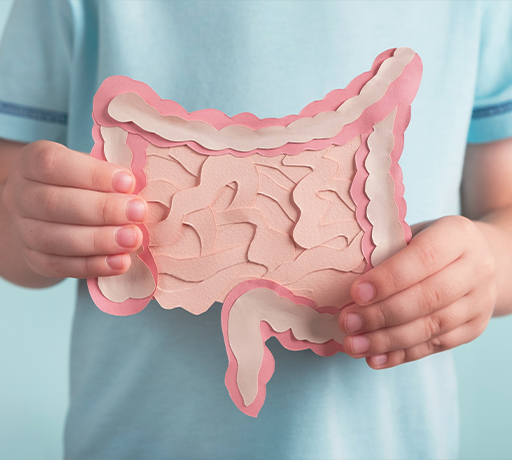Gut impact on the brain
Another important element in the gut-brain axis consists of the trillions of bacteria and other microorganisms that reside in your child’s gut (gut microbiome).2
Here are some of the things we know about how the gut microbiome could impact the brain.5, 6, 7, 8
- They produce certain chemicals that influence the brain’s function, for example, short-chain fatty acids like butyrate and propionate that influence how the brain regulates appetite.
- They encourage immune cells in the gut to produce cytokines that travel to the brain via blood. Cytokines are a type of protein that trigger the immune system to do its job.
- Neurochemicals produced by gut bacteria are used by the brain to regulate cognitive processes like memory and learning.
- Ninety-five percent of the body’s serotonin, which influences mood, is produced by gut bacteria.
Given this intricate relationship between the gut, its microbiome, and the brain, it is important that parents keep their toddler’s gut healthy and happy for optimal overall health.
How to support your toddler’s gastrointestinal development
At birth, your baby’s gut is colonised by millions of microbes that form the gut microbiome. This can happen in two ways: via the mother’s birth canal in natural birth, or from the hospital environment in a Caesarean section.9
The development of a healthy microbiome is essential to the optimal development of your child’s GI tract. According to research, three phases of microbial gut colonisation take place in a child following birth spanning four years: a developmental phase from three to 14 months; a transitional phase from 15-30 months; and a stable phase from 31 months onwards.10
Since your little one is now in the transitional phase, it is important to nurture his/her gut, keeping those good bacteria nourished and happy. One of the best ways to do this is through nutrition; specifically foods that are naturally rich in prebiotics that feed those friendly microbes. Most fibre-rich fruits and vegetables contain prebiotics, for example, bananas, green leafy vegetables, and garlic. Other good sources of prebiotics include wholegrains, yoghurt, as well as 2’-FL and prebiotics as such FOS in formula milk. You could also speak to a doctor about supporting your child’s gut with a probiotic supplement. Probiotics are live, beneficial microorganisms.
Ensuring your toddler is not exposed to stressful situations can also help keep the microbiome healthy – research showed that exposure to stress can cause imbalances in the microbiome.11
References:
1 John Hopkins Medicine. The Brain-Gut Connection. Accessed on 5th March, 2022 from https://www.hopkinsmedicine.org/health/wellness-and-prevention/the-brain-gut-connection
2 Lima-Ojeda, J et al. Happy Gut Bacteria, Happy Brain: The Microbiota-Gut-Brain Axis. Frontiers for Young Minds. Published on 11th February, 2019. Accessed on 5th March, 2022 from https://kids.frontiersin.org/articles/10.3389/frym.2019.00015.
3 Breit, S. et al. Vagus Nerve as Modulator of the Brain–Gut Axis in Psychiatric and Inflammatory Disorders. Frontiers in Psychiatry. Published 13th March 2018. Accessed on 5th March, 2022 from https://www.frontiersin.org/articles/10.3389/fpsyt.2018.00044/
4 Sahar, T. et al. Vagal modulation of responses to mental challenge in posttraumatic stress disorder. Biol. Psychiatry. Published 1st April 2001. Accessed on 5th April, 2022 from https://pubmed.ncbi.nlm.nih.gov/11297721/
5 Clarke, G et al. Minireview: Gut Microbiota: The Neglected Endocrine Organ. Mol Endocrinol. Published in August 2014. Accessed on 5th March, 2022 from https://www.ncbi.nlm.nih.gov/pmc/articles/PMC5414803/
6 Chambers, E et al. Control of appetite and energy intake by SCFA: what are the potential underlying mechanisms? Proceedings of the Nutrition Society. Published in December 2014. Accessed on 5th March, 2022 from https://www.cambridge.org/core/journals/proceedings-of-the-nutrition-society/article/control-of-appetite-and-energy-intake-by-scfa-what-are-the-potential-underlying-mechanisms/A1EFBE12AD6F9838EBE3D7314D1EE1B4
7 Howes, L. How your gut might modify your mind. Chemical and Engineering News. Published on 8th April, 2020. Accessed on 5th March, 2022 from https://cen.acs.org/biological-chemistry/microbiome/gut-might-modify-mind/97/i14
8 Carpenter, S. That Gut Feeling. Monitor on Psychology, American Psychological Association. Published in September 2012. Accessed on 5th March, 2022 from https://www.apa.org/monitor/2012/09/gut-feeling
9 Hunt, K. Babies born by C-section have less of their mom’s gut bacteria. Here’s why that might be important. CNN Health. Published on 19th September, 2019. Accessed on 22nd February, 2022 from https://edition.cnn.com/2019/09/18/health/babies-gut-microbiome-birth-vaginal-c-section-intl/index.html)
10 The European Society of Neurogastroenterology and Motility. Infant gut microbiota develops in three stages. Accessed on 5th March, 2022 from https://www.gutmicrobiotaforhealth.com/infant-gut-microbiota-develops-in-three-stages/
11 Madison, A et al. Stress, depression, diet, and the gut microbiota: human–bacteria interactions at the core of psychoneuroimmunology and nutrition. Curr Opin Behav Sci. Accessed on 5th March, 2022 from https://www.ncbi.nlm.nih.gov/pmc/articles/PMC7213601/
.png)
.png)






Stay Connected